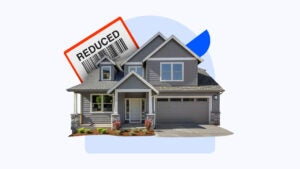No affordable mortgages? This startup could help you take the seller’s loan instead

What if you could buy a home today, but lock in a mortgage rate from 2021?
It sounds too good to be true, but it’s legit: In some cases, a buyer can take over a seller’s low-rate mortgage.
However, few buyers know to look for homes with these so-called assumable mortgages, and few sellers mention the possibility when listing their homes.
As a result, says Raunaq Singh, “These homes are very hard to find.”
Singh is the founder and CEO of Roam, a startup that sifts through the inventory of homes for sale, finds properties with assumable mortgages, then shares the properties on its website.
A way to sidestep high mortgage rates
Mortgage rates are at their highest levels since the year 2000, and home prices remain near record highs. It’s a dreary reality that’s challenging homebuyers and squeezing affordability.As a result, some buyers are waking up to a little-known feature of loans backed by the Federal Housing Administration (FHA), the U.S. Department of Veterans Affairs (VA) and the U.S. Department of Agriculture (USDA): It’s possible for a buyer to take over the seller’s mortgage. (This benefit doesn’t apply to conventional loans, which account for about two-thirds of all mortgages.)
For buyers, the upside is obvious. Say you take over a $300,000 mortgage with a 3.25 percent rate. The monthly payment would be $1,306. Borrowing the same $300,000 at 7.25 percent would equate to a monthly payment of $2,047, based on a 30-year loan.
From another angle: To have a $1,306 payment at a 7.25 percent interest rate, a buyer could only take a mortgage of about $191,000. While loan assumptions remain rare, the concept has been gaining momentum, says Chris Birk, vice president at Veterans United Home Loans, a VA lender. “We’re seeing more and more home listings referencing assumable loans and more interest from prospective buyers,” says Birk.
Tracking down less expensive mortgages
For now, Roam operates in six major markets in Arizona, Colorado, Florida, Georgia and Texas. As of late September, the company had more than 4,000 listings across those six metro areas (Atlanta, Dallas, Denver, Houston, Phoenix and Tampa). Singh hopes to expand nationally.
The company is a licensed real estate broker and a member of multiple listing services, so it has access to homes on the market. It uses public records to compare properties for sale with mortgage data, then narrows the field to homes for sale that are financed by FHA loans or VA loans. (USDA loans can be assumed by a homebuyer, but for now Roam is not operating in the rural areas eligible for USDA financing).
Roam further winnows the options by looking for mortgages with rates less than 5.5 percent, and those that still have a significant balance on the mortgage. It wouldn’t make much sense for a buyer of a $500,000 home to assume the mortgage if the seller owed only $50,000.A recent Zillow search on the phrases “assumable mortgage” and “assumable loan” in the Atlanta area turned up just a handful of properties with those terms in the listing description. Roam’s site lists hundreds of such properties.
“We’ve built the first-ever data feed of homes that are eligible for assumption,” says Singh.
Roam collects a fee of 1 percent of the sale price, so the service isn’t free. Singh says it’s still a good deal for buyers — they score attractive mortgage payments, and they might not have to pay for such closing costs as an appraisal. Lenders commonly include a 1 percent origination fee, so Roam’s fee is in the range of the expenses you’d pay to get a new mortgage. In exchange, Roam says it makes sure the seller’s mortgage company receives all of the required information and follows through to keep the assumption on track.
The rules still apply
Assuming a mortgage isn’t always a straightforward process. If the value of the home is far greater than the mortgage balance, the buyer either would pay cash for the difference or need to find a lender willing to issue a second mortgage and take a second lien position — a riskier proposition for the lender.
Say a seller is asking $500,000 for a home with a mortgage balance of $400,000. The buyer would need to pay the seller $100,000, and then take over payments on the loan. If you have $100,000 in cash, that would serve as your down payment. However, if you have only $50,000 for a down payment, Roam says it will help you find a second mortgage to cover the difference. In that case, you’d have two monthly payments – one for the primary mortgage and another for the second mortgage.You’ll also need to qualify under the seller’s lender’s underwriting guidelines, and only a fraction of homes for sale carry mortgages that are eligible for assumption.
What’s more, the VA rules around loan assumption, specifically, are complicated. A VA borrower can allow a civilian to assume the VA loan, but doing so hinders the VA borrower’s ability to take out future VA loans. If a civilian assumes a VA loan and later defaults, the seller can lose some or all ability to qualify for a VA loan.
“For veteran homeowners, the key is understanding the advantages and potential downsides of an assumption,” says Birk. “Offering an ultra-low rate can certainly help you stand out and maximize sale price. But allowing a non-veteran to assume your loan can limit your ability to reuse your VA loan benefit in the future.”
More strategies for buyers facing higher rates
Assuming a mortgage is just one way to cope with the sharp rise in mortgage rates. Some other tips:
- Boost your credit score. This is the single most important driver of your mortgage rate, so get that score as high as possible. The best rates typically go to borrowers with a 740 score or higher.
- Shop aggressively. Comparing at least three different lenders is a smart move at any time, but in periods of rate volatility, quotes can vary dramatically. Be sure to check in with multiple lenders.
- Look for seller-financed rate buydowns. Temporary buydowns can knock a point or two off your mortgage rate. The good news is that the seller covers the cost. The bad news is that rate buydowns often are offered in lieu of a price reduction.
- Consider paying points. Mortgage points are the fees a borrower pays a mortgage lender to trim the interest rate on the loan, thus lowering the overall amount of interest paid over the mortgage term. This practice is sometimes called “buying down the rate.” It won’t make sense for every borrower, but if you plan to live in the home long enough to realize the savings, the points could be worth paying.
Why we ask for feedback Your feedback helps us improve our content and services. It takes less than a minute to complete.
Your responses are anonymous and will only be used for improving our website.
You may also like

Best FHA mortgage lenders in 2025

How to get a low-cost mortgage refinance




